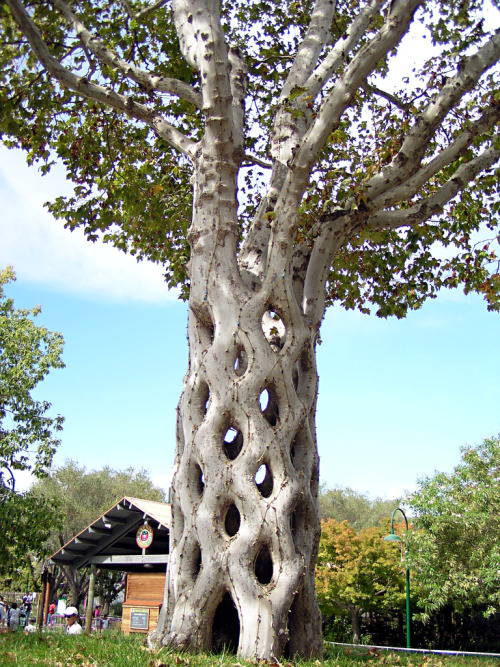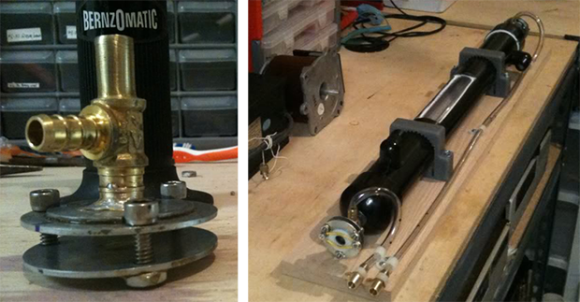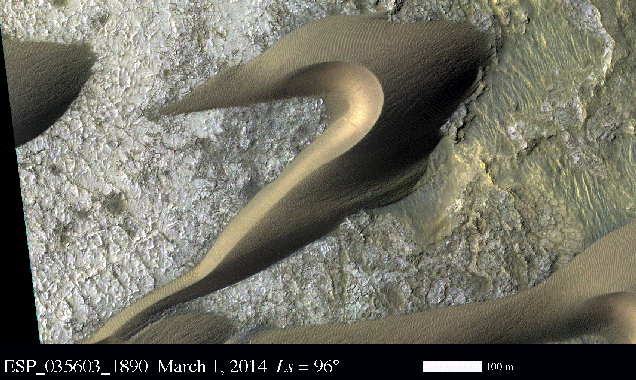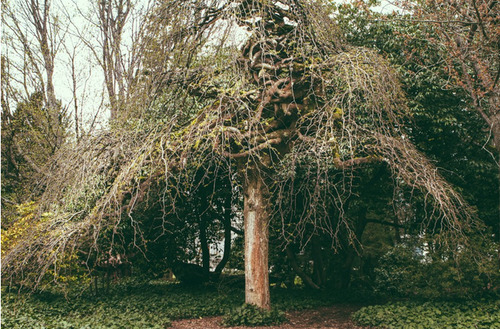Bunker.jordan
Shared posts
1925: Racing driver in a sweater
Peculiar Abstract Sandcastles by ‘Sandcastle Matt’






No these aren’t the homes of mutant sea creatures or geographic oddities forged from centuries of tidal currents, they’re sandcastles built by a Massachusetts man who goes by Sandcastlematt. Using found objects like vines, plywood, and other junk he creates a sturdy framework to which he applies the classic drip method sandcastle technique resulting in these strange temorary structures that look like contemporary land art pieces.
One of Matt’s sandcastles recently made the rounds in a viral meme suggesting his work was the result of lightning striking sand, but Scientific American debunked it. See more of his castles right here.
Warped Street Art Portraiture by Stamatis Laskos









“Every portrait that is painted with feeling is a portrait of the artist, not of the sitter,” said Oscar Wilde. “It is not he who is revealed by the painter; it is rather the painter who, on the coloured canvas, reveals himself.” Never has this quote seemed more true than while admiring the street art of Stamatis Laskos, a 29-year old Greek artist who lives and works in Athens. He creates warped portraits of friends and other everyday people (as well as the occasional animal) through highly stylized depictions that are alive with detail, depth and dimension. Here are a few examples what he’s done over the last few years on the streets of Greece. He’s currently inspiring a group of budding young artists as an art instructor for an elementary school. You can follow him and his elongated necks and legs over on behance.
Recharging aging brains could be in the (young) blood

Section: Medical
Tags: Aging, Alzheimer's Disease, Blood, Brain, Stanford University
Related Articles:
- Harvard researchers find protein that could reverse the aging process
- Naturally occurring compound helps reverse diabetes in mice
- Drugs shown to stop and even reverse Alzheimer's in mice
- Scientists successfully treat Alzheimer’s symptoms in mice
- Easter Island drug improves learning and memory in mice of all ages
- Berkeley researchers find evidence for a "molecular fountain of youth"
darkgob: Captain America gets excited when he understands a...
A New 3D Scan App?
Bunker.jordanooooooohhhhh

Details are few, but IHTFP Labs is developing an app that they say will “Revolutionize 3D Scanning”.
There are no specifications, pricing or technical details available for this product. The only things we know are:
Now you have a 3D scanner with you anywhere you go, in your smartphone. Capture any objects for 3D printing.
Move around any objects with your phone’s camera to capture high-fidelity 3D scans, without any expensive dedicated hardware.
Send your 3D scans to your own printer or to a printing service, select your material and receive your 3D print in your mail.
Sounds good, but who are IHTFP Labs? We’d bet “IHTFP” are the initials of the principals. They say:
We are a team of MIT machine vision scientists and proven entrepreneurs, with more than 20 years of experience in the field. We want to democratize the 3D scanning process by turning your smartphone into a 3D scanner. We believe this has wide applications across many fields.
So it would seem they have the capability to build something like the “Scanner Pal App”. But do we need such a thing?
Definitely yes! We’ve been using various types of 3D scanners, and frankly, they are mostly painful to use. They can be expensive and require expensive, cable-attached laptops to operate. Some require “targets” placed on the scanned objects, which is discomforting to individuals, obviously.
Even the 123D Catch App, which most closely resembles the Scanner Pal App, is sometimes difficult to use. You require highly consistent lighting, correct backgrounds and must wait long periods for your scan to be processed. It’s a free service, so many people endure these barriers.
We’re hoping IHTFP Labs can overcome some of these difficulties. We would like nothing better than to pull a good 3D scanner out of our pockets and go to town on anything nearby. Wouldn’t you?
Via IHTFP Labs
Autodesk prints a virus

Autodesk Builds Its Own Virus, as the Software Giant Develops Design Tools for Life Itself @ Re/code.
Autodesk, which develops design software for building very big things, just built a very small thing. Its own virus. The San Rafael, Calif., company has revealed to Re/code that last month it produced a synthetic Phi-X174 bacteriophage, a virus that infects the E. coli bacteria but is totally benign for humans. They conducted the experiment in a controlled lab setting with the help of Dr. Paul Jaschke of Stanford University.
We thought Autodesk was going to buy a 3D printer company, they’re going to skip that and get a DNA sequencer ![]()
Nano Lure uses a fishbot to catch the big ones
Bunker.jordan... let's just cut to the chase and go to the store and buy fish.

Section: Outdoors
Tags: Biomimicry, Fishing, Kickstarter, Robots
Related Articles:
- FishEyes rod and reel shows you the fish before you catch them
- ReelSonar fish finder incorporates your smartphone
- New BioPulse lure system gives fishermen an unfair advantage
- A computerized fishing rod – sure, why not?
- Adjust-A-Butt brings a new dimension to the fishing rod
- FishHunter Sonar uses a smartphone to show where the fish are
Ancient Egyptians likely used damp sand to help move pyramid-building blocks

Section: Good Thinking
Tags: Construction, History, Sand, Transport, University of Amsterdam
Related Articles:
- Liquid salt could help clean up tar sands
- Sandbag 2.0 – meet the Sand Brick
- Multimat helps keep sandy campers clean
- Beach Pockets secures your sun umbrella
- Zen Table packs a Japanese rock garden and robotic Zen priest in a table
- Dedicated sandbag filling tool five times faster than a shovel
Landscapes Altered by the World’s Largest Statues

The Motherland Call, Volgograd, Russia, 285 ft, built in 1967

African Renaissance Monument, Dakar, Senegal, 161 ft, built in 2010

Ataturk Mask, Buca, Izmir, Turkey, 132 ft, built in 2009

Christ Blessing, Manado, Indonesia, 98.5 ft, built in 2007

Christ the King, Świebodzin, Poland, 120 ft, built in 2010

Grand Byakue, Takazaki, Japan, 137 ft, built in 1936

Guan Yu, Yuncheng, China, 262 ft, built in 2010

Mao Zedong, Changsha, China, 105 ft, built in 2009

Mother of the Fatherland, Kiev, Ukraine, 203 ft, built in 1981

Dai Kannon, Sendai, Japan, 330 ft, built in 1991
Towering above cities and carved into mountainsides, the gargantuan statues captured in Fabrice Fouillet’s series Colosses were designed to dwarf everything in proximity, to stand as timeless monuments of religious and political icons. Though unlike the tourists and pilgrims who travel great distances to witness these towering structures up close, Fouillet is more interested in how the landscape around each monument has been transformed. He shares via his artist statement:
The series “Colosses” is a study of the landscapes embracing those monumental commemorative statues. Although hugeness is appealing, exhilarating or even fascinating, I was first intrigued by the human need to build gigantic declarations. Then, I asked myself how such works could be connected to their surroundings. How can they fit in the landscapes, despite their excessive dimensions and their fundamental symbolic and traditional functions?
That is why I chose to photograph the statues from a standpoint outside their formal surroundings (touristic or religious), and to favour a more detached view, watching them from the sidelines. This detachment enabled me to offer a wider view of the landscape and to place the monuments in a more contemporary dimension.
Fouillet references a wave of “statuemania” in the 1990s in locations mostly around Asia where many more sculptures are still under construction. The world’s tallest monument, a tribute to the the independence hero Sardar Patel in India, will soon reach a soaring height of 182 meters, nearly twice that of the Statue of Liberty. You can see much more of the series over on his website. All photos courtesy the photographer. (via Slate)
More Evidence That Youthful Blood Can Reverse The Effects Of Aging
Bunker.jordan... don't tell Twilight fans.
Watch The Winds Whip Across The Surface Of Mars
reallifescomedyrelief: viforcontrol: beautifuloutlier: gwydthe...

Circus Tree: Six individual sycamore trees were shaped, bent, and braided to form this.
how the hell do you bend and braid a tree
Actually pretty easy. Trees don’t reject tissue from other trees in the same family. You bend the tree to another tree when it is a sapling, scrape off the bark on both trees where they touch, add some damp sphagnum moss around them to keep everything slightly moist and bind them together.
Then wait a few years- The trees will have grown together.
You can use a similar technique to graft a lemon branch or a lime branch or even both- onto an orange tree and have one tree that has all three fruits.
Frankentrees.As a biologist I can clearly state that plants are fucking weird and you should probably be slightly afraid of them.
On that note! At the university (UBC) located in town, the Agriculture students were told by their teacher that a tree flipped upside down would die. So they took an excavator and flipped the tree upside down. And it’s still growing. But the branches are now the roots, and the roots are now these super gnarly looking branches. Be afraid.
But Vi, how can you mention that and NOT post a picture? D:
[source]
I admire that level of spite. “Teacher told us a tree would die if flipped upside down? Chet go steal an excavator, we are going to show that motherfucker what’s what.”
noodleweight: catsgomeowalot: my new favorite gum what the...
The 5 brightest planets in May’s night sky: How to see them (and when) #space
Space.com has a great post detailing how and when to see the 5 planets that will be visible in the night sky this May.
This month, stargazers have a chance to see the five brightest planets in the sky, weather permitting, as they make appearances in the evening after sunset or as predawn spectacles. And on occasion, the moon will pass by to enhance the celestial view.
The May night sky planets are Jupiter, Saturn, Mercury, Venus and Mars, and all are shining bright this month. Here, we present a schedule below which provides some of the best planet viewing times as well directing you as to where to look to see them.
Remember, that you can use your clenched fist at arm’s length — equal to roughly 10 degrees of the night sky — to measure off angular distances. The brightest stars in the sky are equal to first or zero magnitude, while the very brightest objects are of negative magnitude. Here’s a look at when to see the brightest planets in the May night sky (note, all skywatching is dependent on your local weather conditions):
May 4 and 5: As darkness falls, look westward to see a fat waxing crescent moon and about 8 degrees to its right isthe brilliant planet Jupiter, shining at a magnitude -2. Jupiter and the moon shine together roughly one-third up from the horizon to the point directly overhead and will set at around 12:45 you’re your local time. This is the last month (until September) in which this biggest of planets is high enough in a dark sky to permit crisp telescope views of its cloud patterns and four big satellites.
May 10: Saturn reaches opposition; it rises in the east-southeast at dusk, is due south in the middle of the night and sets in the west-southwest at dawn. Once it gains enough altitude, it appears similarly as bright as the zero-magnitude stars Arcturus and Vega. The planet’s famous rings appear much more impressive than in recent years, since they are now tipped by 21.5 degrees from edge on.
May 11: Looking low toward the south-southeast early this evening, you’ll see the waxing gibbous moon keeping company with a bright star and a bright planet. About 6 degrees to the moon’s lower left is the bluish first-magnitude star Spica. And about 8 degrees to the moon’s upper right is yellow-orange Mars, now coming down in brightness from last month’s opposition. Currently at magnitude -0.9, it’s nearly half as bright as it was just one month ago; the Red Planet has receded to a distance of 63.8 million miles (102.6 million kilometers) from Earth.
May 13 and 14: During the overnight hours watch how the moon’s position relative to Saturn changes. At dusk on May 13, look toward the east-southeast. Saturn will appear about 5.5 degrees to the lower left of the moon. The moon will move toward Saturn at its own apparent width (a half-degree) per hour during the night. So by dawn on May 14, the duo will be low in the west-southwest; the moon having moved to within 2.5 degrees to the lower right of the ringed planet. From the southern half of Australia, New Zealandand Victoria Land (Antarctica), the moon will occult (hide) Saturn.
May 25: Venus and a slender crescent moon make for an eye-catching celestial tableau in the night sky before dawn on this morning low in the eastern sky about 45 minutes to an hour before sunrise.
Mercury also attains its greatest elongation — or greatest angular distance — east of the sun (23 degrees). This is Mercury’s best evening apparition of the year; it sets about 100 minutes after sunset. An hour after sunset, look low above the west-northwest horizon; the speedy planet should be easily visible as a yellowish star shining at magnitude 0.6. Mercury will appear somewhat brighter up to two weeks before this date, and noticeably dimmer for about a week afterwards.
May 30: Having faded to magnitude +1.1, Mercury can be found about an hour after sunset roughly 7 degrees to the right and a bit above the 2.5-day-old waxing crescent moon.
Environmentally friendly solar cell pushes forward the ‘next big thing in photovoltanics’
Phys.org has the story on the latest in photovoltaics.
Northwestern University researchers are the first to develop a new solar cell with good efficiency that uses tin instead of lead perovskite as the harvester of light. The low-cost, environmentally friendly solar cell can be made easily using “bench” chemistry—no fancy equipment or hazardous materials.
“This is a breakthrough in taking the lead out of a very promising type of solar cell, called a perovskite,” said Mercouri G. Kanatzidis, an inorganic chemist with expertise in dealing with tin. “Tin is a very viable material, and we have shown the material does work as an efficient solar cell.”
Kanatzidis, who led the research, is the Charles E. and Emma H. Morrison Professor of Chemistry in the Weinberg College of Arts and Sciences.
The new solar cell uses a structure called a perovskite but with tin instead of lead as the light-absorbing material. Lead perovskite has achieved 15 percent efficiency, and tin perovskite should be able to match—and possibly surpass—that. Perovskite solar cells are being touted as the “next big thing in photovoltaics” and have reenergized the field.
Kanatzidis developed, synthesized and analyzed the material. He then turned to Northwestern collaborator and nanoscientist Robert P. H. Chang to help him engineer a solar cell that worked well.
“Our tin-based perovskite layer acts as an efficient sunlight absorber that is sandwiched between two electric charge transport layers for conducting electricity to the outside world,” said Chang, a professor of materials science and engineering at the McCormick School of Engineering and Applied Science.
White Death

In the municipality of Rautjärvi near the Soviet/Finnish border, 34-year-old Simo Häyhä was a farmer and hunter leading a flagrantly unexciting life. Upon news of the hostilities, he gathered up food, plain white camouflage, and his iron-sighted SAKO M/28-30–a variant of the Soviet Mosin-Nagant rifle–and went to defend his country. Before the four-month war ended, humble Häyhä would gain infamy among the Russian invaders, and come to be known as the “White Death.”
Building A CO2 Laser In A Hardware Store

Over on the Projects site, [ThunderSqueak] is pushing the bounds of what anyone would call reasonable and is building a CO2 laser from parts that can be found in any home improvement store.
Despite being able to cut wood, paper, and a bunch of other everyday materials, a carbon dioxide laser is actually surprisingly simple. All you need to do is fill a tube with CO2, put some mirrors and lenses on each end, and run an electric current through the gas. In practice, though, there’s a lot of extra bits and bobs required for a working laser.
[ThunderSqueak] will need some sort of cooling for his laser, and for that he’s constructed a watercooling jacket out of 2″ PVC. In the end caps, a pair of brass pipe fittings are JB Welded in place, allowing a place for the mirror assembly and lenses.
The mirror mounts are the key component of this build, but the construction method is surprisingly simple. [ThunderSqueak] is using a few brass barbed hose fittings, with washers stuck on one end. The washers are drilled to accept a trio of bolts that will allow the mirrors to be perfectly parallel; anything less and the CO2 won’t lase.
The build isn’t complete yet, but having already built a few lasers, there’s little doubt [ThunderSqueak] will be able to pull this one off as well.
Filed under: laser hacks
1949-1961: President Perón’s locomotive “Argentina”






“Argentina” was had a striking streamlined external appearance inspired by locomotives built in USA, UK and France. It remains one of the most efficient steam railway locomotives of all time.’Argentina’ was painted in the colours of the Argentine flag – white and sky blue. Unusually for a steam locomotive the bulk of the machine was painted white with one broad blue band and two narrower ones low down on each side.
“Peron lost power in 1955 after which the locomotive lost all the ‘Presidente Perón’ nameplates. At this point the locomotive gained two more ‘Argentina’ plates and remained with these until withdrawn.”
Scientists develop GPS for DNA

Scientists have developed a GPS tool for your DNA, from Geek.
This technique relies on parsing out so-called genetic admixture, a process by which previously separated populations recombine over time and interbreed. The tool makes estimates about a subject’s genetic origins by using 100,000 DNA signatures as a baseline. The researchers claim the tool is considerably more powerful than previous methods because it uses all 44 diploid autosomal chromosomes, as opposed to the two sex chromosomes.
To demonstrate the effectiveness of GPS, the researchers tested residents of 10 villages in Sardinia. The results of this test placed 25% in the correct village, and the remainder in less than 50km of their true origins. Residents of 20 islands in Oceania were also analyzed using GPS, with 90 being placed on the right island based entirely on their DNA.
It’s actually a remarkably simple tool when you get down to it — GPS is essentially triangulating a person’s geographic origin based on genetic ratios. That’s why it gives an exact location that might be close to, but a few miles away from, a person’s ancestral village. This also means GPS is more useful for individuals who have fairly uniform heritage — someone whose parents were from vastly different backgrounds might be placed in the middle of an ocean. Although, the system offers more data on genetic makeup than the final location.
Fumo rewards smokers for disposing of their butts

Section: Good Thinking
Tags: Cigarettes, Interactive, Smoking, Ultrasonic, Waste
Related Articles:
- Greenbutts cigarette filters sprout flowers when planted
- Save those cigarette butts, and use them to protect steel
- City of Vancouver launches cigarette butt recycling program
- Harm-reduction gadget helps smokers quit
- Snowball Launcher prevents pitcher's elbow
- SuperSmoker electronic cigarette launched in UK
Remote control drone keeping geese at bay #drone #droneday
Aerial Perspective founder Steve Wambolt originally tried to sell the city a means to survey city property using a remote control drone. When Orléans Ward Coun. Bob Monette saw the presentation he thought of another use for the device.
Petrie Island has been plagued with marauding Canada Gesse ever since the city turned the former sand quarry into a public beach and landscaped it with grass. That was in 2007.
Over the years the migrating geese population has grown into well over 100. The geese graze on the grass, leaving their feces in their wake. The feces break down when it rains and leaches into the sand and the water causing high levels of e-coli bacteria.
Hive-Inn: A Hotel of the Future Made From Shipping Crates
Bunker.jordan#KaijuJenga

Architechts at Hong Kong’s Ova Studio have developed the idea of a hotel made entirely from shipping crates that move in an out of a metal frame. From FastCoExist:
“Containers are designed to be stackable on one another, like Legos, to facilitate transportation and insure stability,” explains Slimane Ouahes, director of OVA. “Usually, container buildings use this to easily and quickly put up a building, but that immobilizes the container in a final resting place. We wanted to keep the true nature of containers alive: Containers are mobile, containers travel.”
In a disaster, units for housing, medical services, schools, or government agency offices might be quickly shipped to a site and slotted into place. Each container could be fully built off-site, so construction wouldn’t disturb current residents. As needs change, containers could easily come and go.
An insert under each container hooks the unit up with electricity, partially generated from the building’s waste, and water. The insert even supplies soil for growing a small kitchen garden. If a container is taken out, the designers say that a little bit of nature can come back: The exposed soil can be used to grow wildflowers and support bees.

Cutaway illustrations of nuclear reactors
Erasing Your DNA May Soon Be As Easy As Cleaning Your Kitchen Counter

Though it sounds like something out of a network crime drama, anti-DNA spray may now be a reality. Invisible is a spray that erases and obscures your DNA. Zack Sokol from The Creators Project writes:
Invisible includes a suit of two products that can be used like a disinfectant spray—”Erase” removes 99.5% of DNA material on any surface while “Replace” obfuscates the remaining .5% through a cloaking mist of arbitrary genetic gunk. “Instead of subjecting their own DNA to covert analysis, Invisible customers can leave an alternate DNA sample, designed for their protection,” writes the Invisible website.
It’s tough to fully believe this is a product that will eventually be sold in your average Duane Reade. Yet Invisible is persistent in its seriousness. From its press release: “DNA is routinely extracted and often stored from infants at birth…and law enforcement now routinely profiles individuals convicted of even petty crimes, tending toward permanent storage of both profiles and biological samples form individuals arrested for but never convicted of a crime.” It also includes statistics such as that it only takes .5 nanograms of DNA required for standard forensic analysis, and that there is 108 nanograms of DNA in a microliter of saliva. Even if the risk of genetic theft isn’t a real concern (yet), we’re definitely leaving identifying material all over the place.
Though it all sounds like a sci-fi conceptual art project, we’re pretty certain this isn’t a ploy. For one thing, it was created by Heather Dewey-Hagborg, known for her Stranger Visions project where she picked up stray hairs, finger nails, and other genetic material found in public places and used the DNA contained to construct speculative portraits of what the “anonymous shedders” might look like based on their genetic profiles. Secondly, though Invisible’s website incorporates plenty of fear mongering, it also includes a litany of peer-refereed sources about synthesized DNA and genetic crime that are convincing enough to make any skeptic realize that faking DNA or stealing others’ is not an impossibility. Either way, if the ratings of CSI are any indication, we’re sure this will some market value.















